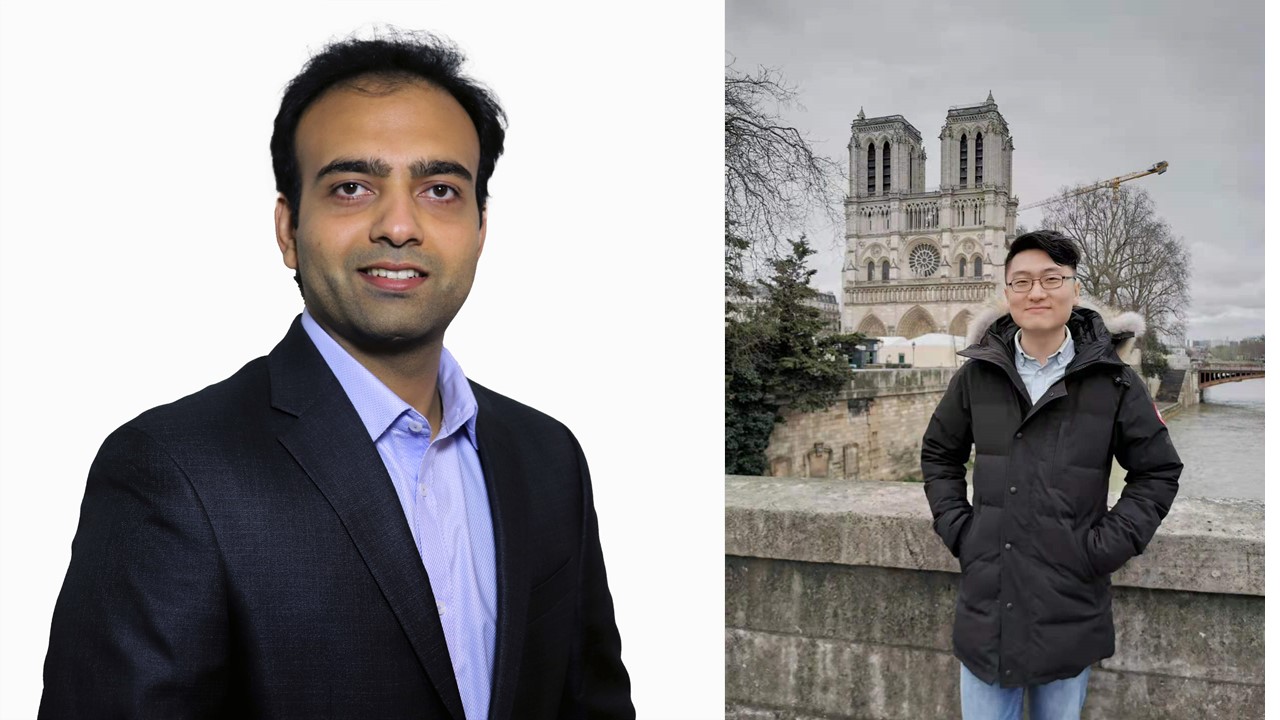For Orlov Lab learners, no advantage too small

Welcome to the Orlov Materials Laboratory where Professor of Materials Science and Chemical Engineering, Alexander Orlov, leads PhD candidates and a world-class assemblage of scientific collaborators on a quest of nanoscopic – and unfathomably huge – proportions.
Working at the intersection of chemistry, materials science and environmental engineering, the Orlov Group is living large with nanoparticles – tuning their tiny sizes, shapes and compositions to encourage the highest-possible catalytic activity, with an eye on revolutionizing low-carbon energy production.
Naturally, such large-scale ambition requires super-huge brains. Two of the group’s biggest belong to a pair of PhD candidates, each on course for a materials science doctorate in 2022: Shrish Patel, who earned an undergraduate degree in surface coating technology in 2014 from India’s Institute of Chemical Technology, and Haotian Yang, who earned a bachelor’s degree in materials science and engineering in 2017 from China’s Huazhong University of Science and Technology.
Shrish’s focus in the Orlov Lab harkens to one of the professor’s primary missions, shared with Stony Brook University’s Clean Energy Business Incubator Program: the removal of dust deposits on solar panels stationed in deserts, where sand buildup can cause power losses up to 25 percent.
To that end, Shrish is developing an “electric field-assisted autonomous dust-removal technology,” inspired by NASA technology and designed to restore a solar panel’s output to 98 percent of capacity.
“The advantage of using such techniques is that they reduce environmental impact by reducing water waste,” he says, “and preventing micro-scratches caused by frequent mechanical cleaning of the surface.”
Shrish has been extensively involved in grant writing and the publication of scientific literature on the process; he has personally collected a trophy case of academic awards and conducted more than 200 potential-customer interviews, while helping to raise more than $200,000 to fund the research through NYSERDA’s PowerBridgeNY startup-accelerator program.
Haotian, meanwhile, is currently juggling two projects related to nanostructure applications: One designs nanoparticle catalysts for exhaust-gas treatment (removing toxic carbon monoxide, for instance), the other characterizes nanostructures produced by helium droplets (of particular interest to the Air Force Research Laboratory).
“For example, we proved that gold nanoparticles deposited by such method are active toward the carbon-monoxide oxidation reaction,” Haotian says – essentially, a unique method for synthesizing uniform, extremely clean and very stable nanoparticles.
Both PhD candidates praise Dr. Orlov as a teacher and a mentor. Shrish, who’s worked under the professor’s wing for five years, says Dr. Orlov has “provided me various research and professional development opportunities,” including introductions to the powers that be at PowerBridgeNY, where “we worked together to explore the commercial potential of the … self-cleaning solar panel (technology)” they co-developed in the lab.
Haotian, who first enrolled in Dr. Orlov’s Impact of Materials in Environment class in 2018, agrees the professor excels as a mentor, particular when it comes to “giving students enough freedom in research.”
“He always asks us to draft experiment plans independently before detailed discussion,” Haotian notes. “When it comes to the experiment, he will let us do the experiment first and point out the problems afterward.
“I think it is very helpful for academic-thinking training.”
The professor imparts other life lessons as well – instruction perhaps not directly related to the work at hand, according to Haotian, but still essential to its success.
“He likes to share life experiences with us,” Haotian says. “Like, how to learn from other smart people and how to be positive during failures.”
Both students, meanwhile, rave about the Advanced Energy Research and Technology Center (AERTC), praising everything from the technological and material resources to the opportunity for cross-discipline scientific collaboration.
Shrish applauds the “varied research teams that solve energy and environmental concerns through revolutionary science and technological solutions” and says access to the Thermomechanical & Imaging Nanoscale Characterization (ThINC) laboratory, the Center for Integrated Electric Energy Systems (CIEES) and Stony Brook’s Laser Solar Photovoltaic Laboratory has been “quite helpful.”
“These centers provided me with access to equipment and facilities that would have been impossible to obtain otherwise,” he adds.
Haotian is equally enthused about the hands-on resources.
“We have a water-splitting system in the AERTC which utilizes UV light to produce H2 and O2 from water,” he says. “We have published multiple papers based on that system.
“Also, we used the system to collaborate with Prof. John Parise’s group (in the Department of Geosciences),” he adds. “The scientists from the [School of Marine and Atmospheric Sciences] also characterize their samples using the system.”
The bottom line, according to the young researchers, is their PhD pursuits would be very different without Dr. Orlov’s sage guidance and the AERTC’s significant advantages.
“I have attended the Advanced Energy Conference twice, allowing me to expand my professional network and gain exposure to new research areas in the fields of energy and environmental science,” Shrish says. “The success of my research was made possible by the AERTC's scientists, engineers, technicians and professionals.
